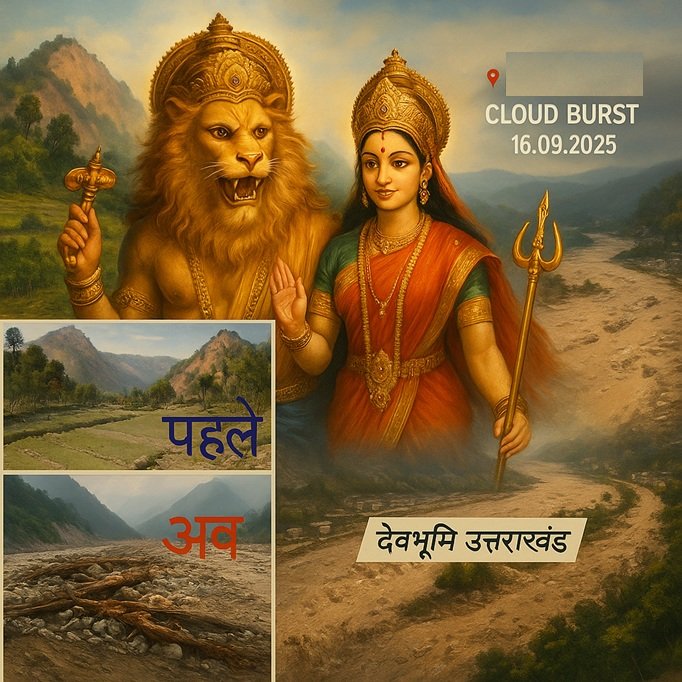-
Ayesha Aryan Rana posted an update in the group VRIGHT PATH-Clarity & Actions to Bridge Your Karma Gaps
1 month, 2 weeks ago#HappyNavratri2025
Why Hindu Gods Took Animal Avatars — and What Nature’s “Anger” Is Reminding Us Today
The pristine valleys of Uttarakhand have once again echoed with the devastating roar of nature’s fury. On August 5, 2025, Dharali village in Uttarkashi district experienced a catastrophic cloudburst, claiming many lives and leaving many more people missing.
This latest disaster, followed by further incidents in Dehradun, Tehri Garhwal, and Chamoli districts on 16th September 2025, underscores the fragile Himalayan ecosystem’s vulnerability and our inadequate preparedness for nature’s increasingly unpredictable behavior.
When the year 2025 opened with raging wildfires in Los Angeles, followed by earthquakes in the Himalayas and devastating floods across India, Pakistan, and China, many described it as if “nature itself is angry.”
Within just a few years of the COVID-19 pandemic, the world has endured a relentless chain of disasters: deadly quakes in Turkey and Nepal, unprecedented monsoon floods across South Asia, heatwaves scorching Europe, and typhoons devastating the Pacific.
Tens of thousands have perished, millions have been displaced, and economic costs run into trillions.
But Sanatan Dharma offers a profound lens to understand this turmoil. For millennia, Indian seers never saw nature as separate from divinity. Rivers were mothers, mountains were fathers, trees were protectors, and animals were embodiments of wisdom.
Even the Gods themselves took forms drawn from nature. Vishnu did not only descend as humans — he became fish, tortoise, boar, lion. Durga manifested as mountain’s daughter, cosmic mother, warrior, and destroyer of darkness.
The message was clear: the divine is embedded in Earth’s very fabric. When humans dishonor that interdependence, imbalance follows — what we now call the climate crisis.
Perhaps no story captures this fusion more powerfully than Narasimha. The demon-king Hiranyakashipu had secured a boon: he could not be killed by man or woman, by day or night, inside or outside. It seemed he had outwitted even the cosmos.
But when arrogance threatened cosmic order, Vishnu appeared not as man, not as beast, but as Narasimha — half-lion, half-human, a form that was neither male nor female, neither day nor night, neither indoors nor outdoors.
In this moment, the essence of Devi and Vishnu merged, showing that when rigid boundaries collapse, creation finds balance again.
This is the deeper wisdom of Hindu mythology: that divinity works on two levels. Vishnu’s avatars teach us how the divine acts outwardly in nature to preserve balance — in water, earth, air, and ecosystems.
Devi’s nine forms (Navadurga), by contrast, map the inward journey of human evolution — from grounding and discipline, to courage, purification, and liberation. One preserves the outer world, the other transforms the inner.Together, they form a complete blueprint for living with balance in an age of climate upheaval.
The Fusion of Devi and Vishnu Avatars
1. Shailaputri × Matsya (Earth’s Daughter & The Fish)
• Wisdom: Both forms root us to the basics of survival — earth (Shailaputri) and water (Matsya).• Lesson: Respect for the earth’s foundation and water bodies.
• Action: Conserve soil, rivers, and groundwater; start community clean-water initiatives.2. Brahmacharini × Kurma (Austerity & The Tortoise)
• Wisdom: Brahmacharini’s penance mirrors Kurma’s patience.
• Lesson: Slow, disciplined living is ecological living. Endurance sustains life.
• Action: Adopt mindful consumption — reduce plastic, choose slow fashion, walk/cycle instead of speed-driven waste.3. Chandraghanta × Varaha (Courage & The Boar Who Saved Earth)
• Wisdom: Chandraghanta’s roar dispels fear, Varaha lifts the earth itself.
• Lesson: Courage is needed to rescue Earth from destruction.
• Action: Fight for land, forests, soil health; support afforestation, stand against destructive mining.4. Kushmanda × Narasimha (Cosmic Creator & Fusion of Man-Beast)
• Wisdom: Kushmanda radiates life-force; Narasimha embodies righteous power.
• Lesson: Creation must be balanced with control over pride and greed.
• Action: Use solar energy, clean tech, and innovation responsibly — not exploitatively. Promote harmony between human tech and natural ecosystems.5. Skandamata × Garuda (Motherhood & Sky’s Eagle)
• Wisdom: Skandamata nurtures life, Garuda soars for freedom.
• Lesson: Nurture isn’t just maternal; it’s ecological guardianship of the air, children, and future.
• Action: Plant trees for clean air, fight deforestation, and protect bird habitats. Raise eco-conscious children.6. Katyayani × Vamana (Warrior & The Dwarf Who Balanced Power)
• Wisdom: Katyayani slays demons, Vamana humbled the arrogant king.
• Lesson: Justice and balance are needed against forces of greed and over-expansion.
• Action: Resist corporate overreach, demand fair land use, regulate polluters, and encourage ethical governance.7. Kalaratri × Parashurama (Darkness Destroyer & The Warrior with Axe)
• Wisdom: Both are fierce — one destroys fear, the other resets injustice.
• Lesson: Sometimes radical action is required to cut down exploitation.
• Action: Stand against deforestation, illegal logging, and corruption in environmental policy. Support grassroots defenders of the land.8. Mahagauri × Rama (Purity & Dharma Restorer)
• Wisdom: Mahagauri brings cleansing, Rama restores order.
• Lesson: Purity of heart and leadership in dharma can heal broken systems.
• Action: Live simply, demand clean governance, and embody ecological ethics in daily life.9. Siddhidatri × Krishna (Fulfillment & Harmony with Nature)
• Wisdom: Siddhidatri grants siddhis (perfections); Krishna teaches harmony through love, music, and play.
• Lesson: The ultimate state is coexistence, joy, and balance between humans, animals, and nature.
• Action: Build communities that celebrate nature — eco-villages, sustainable festivals, organic farming, music/art inspired by ecology.The Integrated Wisdom
• Devi teaches us the inner journey — courage, discipline, purity, and liberation.
• Vishnu teaches us the outer journey — protecting land, water, air, and species.
• Together, they form a 360° action plan for life and sustainability.
Action Plan for every Today and Tomorrow• Ecological Dharma – See environmental action as spiritual duty, not charity.
• Personal Austerity – Simplify consumption, echoing Brahmacharini & Kurma.• Courage for Earth – Like Chandraghanta-Varaha, stand up for land and water rights.
• Innovation with Responsibility – Harness Kushmanda’s creation energy without becoming destructive like unchecked Narasimha rage.
• Community Nurture – Skandamata + Garuda remind us: protect air, raise children as eco-guardians.
• Fight Injustice – Katyayani & Vamana call for challenging exploiters.
• Radical Reset – Kalaratri & Parashurama energy for bold systemic change.
• Restore Dharma – Mahagauri + Rama urge us to purify systems with ethics.
• Celebrate Harmony – Siddhidatri + Krishna invite us into joyful, creative, eco-conscious living.
In short: Navadurga shows us how to evolve inwardly, Dashavatara shows us how to act outwardly. Together, they are not mythology, but a blueprint for climate-age survival and spiritual flourishing.
Wishing everyone a blessed and inspiring Navratri 2025!
May the divine energy of Devi guide us to nurture our inner selves and protect the world around us.


